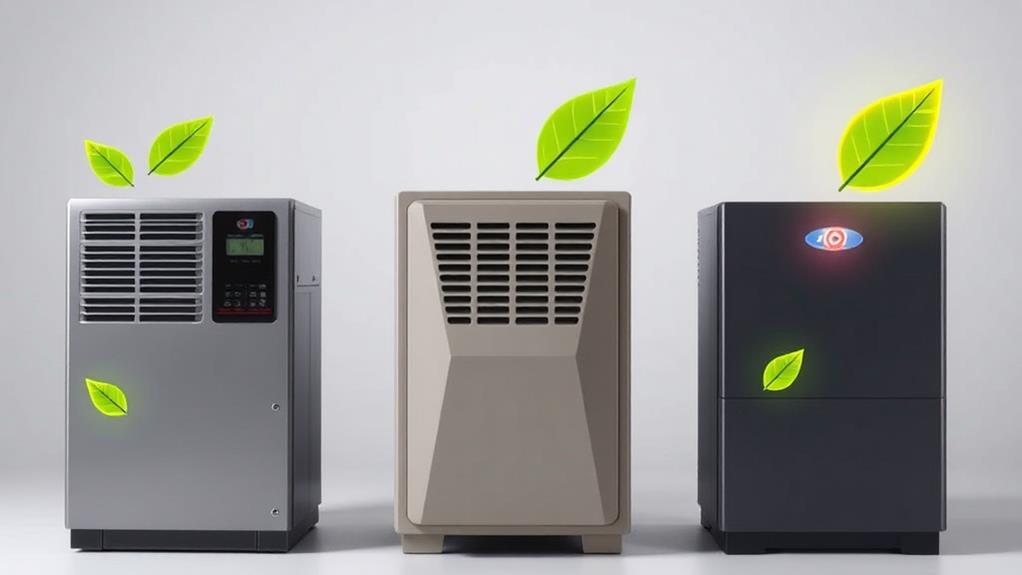When choosing an energy-efficient furnace, you'll need to weigh the pros and cons of gas, oil, and electric options. Gas furnaces offer high efficiency (up to 98% AFUE) and lower operating costs but require gas lines. Oil furnaces provide high heat output for cold climates but are less efficient and have higher maintenance needs. Electric furnaces are simple to install and maintain but can be costly to operate, especially in colder regions. Consider both upfront costs and long-term energy expenses when making your decision. Your choice will also impact your home's environmental footprint, so it's worth exploring each option in detail.
Understanding Furnace Efficiency Ratings
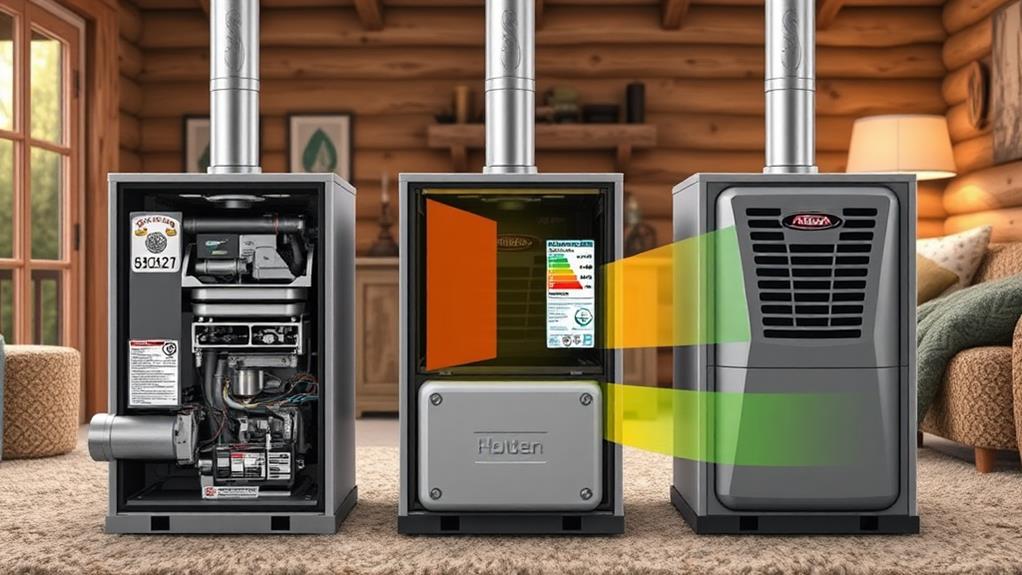
Efficiency ratings are key to understanding how well a furnace performs. When you're in the market for a new furnace, you'll encounter two main efficiency metrics: Annual Fuel Utilization Efficiency (AFUE) and Heating Seasonal Performance Factor (HSPF).
AFUE is the standard measure for gas and oil furnaces. It represents the percentage of fuel converted into usable heat over a year. For example, a furnace with 95% AFUE turns 95% of its fuel into heat, wasting only 5%. Modern high-efficiency furnaces can achieve AFUE ratings of up to 98.5%.
HSPF applies to electric heat pumps and measures their efficiency in both heating and cooling modes. It's calculated by dividing the total heat output during a typical heating season by the total electricity consumed. The higher the HSPF, the more efficient the unit.
When comparing furnaces, remember that higher efficiency ratings generally mean lower operating costs but higher upfront prices. You'll need to weigh these factors against your climate, energy prices, and long-term plans to determine the most cost-effective option for your home.
Gas Furnaces: Pros and Cons
Gas furnaces remain a popular choice for homeowners due to their widespread availability and relatively low fuel costs. They're known for their efficient heating capabilities, especially in colder climates. You'll find that gas furnaces can quickly warm up your home, providing consistent and comfortable heat throughout.
One of the main advantages of gas furnaces is their cost-effectiveness. Natural gas is generally cheaper than electricity or oil, which can lead to lower utility bills. They're also highly efficient, with some models achieving up to 98% AFUE ratings. This means you'll waste less energy and reduce your carbon footprint.
However, gas furnaces aren't without drawbacks. They require a natural gas line, which may not be available in all areas. There's also a risk of carbon monoxide leaks, so you'll need to install and maintain carbon monoxide detectors. Regular maintenance is crucial to ensure safe operation and optimal performance. Additionally, gas furnaces have a shorter lifespan compared to electric models, typically lasting 15-20 years. You'll also need to consider the initial installation costs, which can be higher than those of electric furnaces.
Oil Furnaces: Advantages and Disadvantages
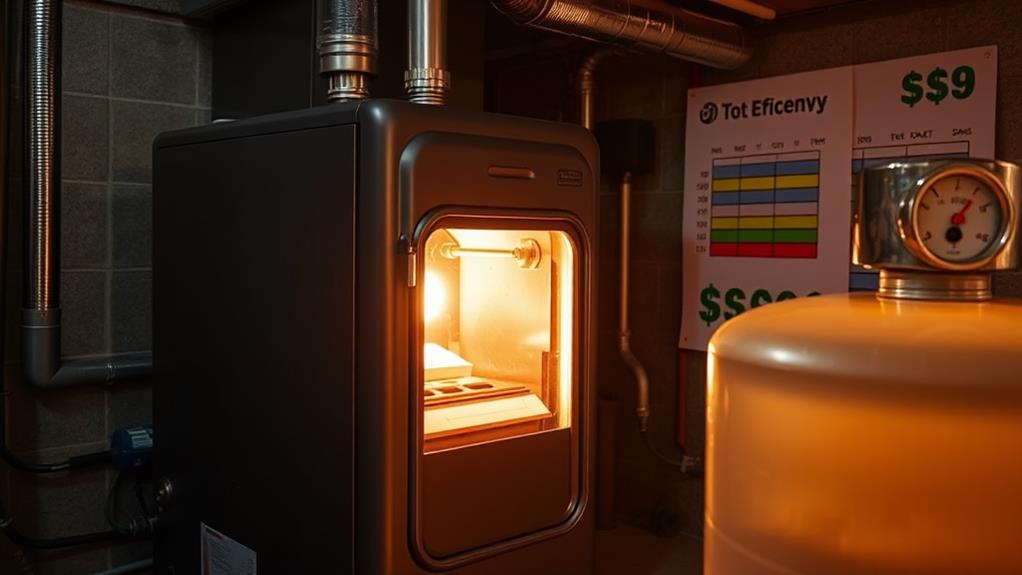
While less common than gas furnaces, oil furnaces remain a viable heating option for many homeowners. They're particularly prevalent in areas where natural gas isn't readily available. Oil furnaces offer several advantages, including higher heat output compared to other fuel types. This means they can warm your home quickly and efficiently, even in extremely cold climates.
Another benefit is that oil furnaces typically have a longer lifespan than gas or electric models, often lasting 15-20 years with proper maintenance. You'll also find that oil prices can be more stable than natural gas, potentially leading to more predictable heating costs.
However, oil furnaces come with some drawbacks. They're generally less energy-efficient than gas furnaces, which can result in higher fuel costs over time. You'll need to have an oil storage tank on your property, which requires regular refilling and maintenance. Oil furnaces also produce more pollutants than gas or electric options, making them less environmentally friendly. Additionally, they require more frequent cleaning and maintenance to prevent soot buildup and ensure optimal performance. Consider these factors carefully when deciding if an oil furnace is right for your home.
Electric Furnaces: Benefits and Drawbacks
Electric furnaces stand out from among the various heating options for their simplicity and clean operation. They're easy to install and maintain, requiring no fuel storage or complex venting systems. You'll find that electric furnaces are generally quieter than their gas or oil counterparts and pose no risk of carbon monoxide leaks.
However, electric furnaces come with some significant drawbacks. They're typically more expensive to operate than gas or oil furnaces, especially in regions with high electricity rates. You'll notice this impact on your monthly energy bills.
While they're 100% efficient in converting electricity to heat, the overall efficiency is lower when considering the energy lost in electricity generation and transmission.
Electric furnaces also tend to heat your home more slowly than other types, which can be a disadvantage in colder climates. They may struggle to maintain comfortable temperatures during extreme cold spells. Additionally, their reliance on electricity makes them vulnerable to power outages, potentially leaving you without heat when you need it most.
Consider your local climate, energy costs, and personal preferences when deciding if an electric furnace is right for you.
Cost Comparison of Furnace Types
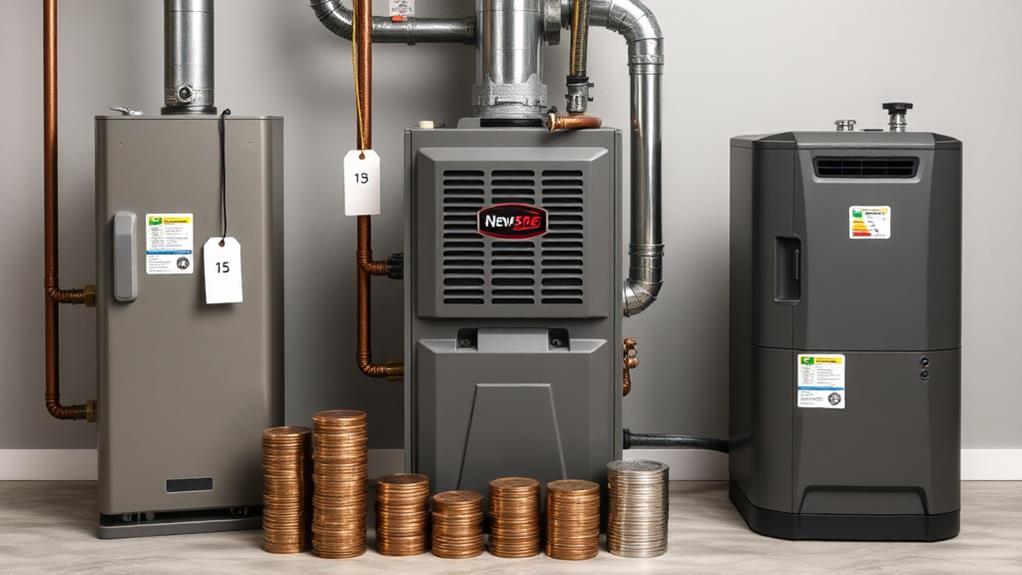
When considering a new furnace, understanding the cost implications of different types is crucial for making an informed decision. Gas furnaces typically have the lowest upfront costs, ranging from $2,000 to $5,000 installed. They're also relatively inexpensive to operate due to lower natural gas prices.
Oil furnaces cost slightly more, usually between $2,500 and $6,000 installed, with higher operational costs due to fluctuating oil prices.
Electric furnaces are often the most affordable to purchase and install, costing between $1,500 and $4,000. However, they're generally the most expensive to operate, especially in colder climates, due to higher electricity rates. Heat pumps, which can both heat and cool your home, have higher initial costs of $4,000 to $7,500 but can be more energy-efficient in moderate climates.
When comparing costs, you'll need to consider both the initial investment and long-term operational expenses. Factor in your local energy prices, climate, and the furnace's efficiency rating. Remember that while a less expensive furnace may save you money upfront, a more efficient model could lead to significant savings over its lifespan through reduced energy bills.
Environmental Impact Considerations
In recent years, environmental impact has become a crucial factor in choosing a furnace. When considering gas, oil, and electric furnaces, you'll need to weigh their effects on the environment carefully.
Gas furnaces are generally more efficient than oil furnaces, producing fewer greenhouse gas emissions. However, they still release carbon dioxide and other pollutants. Natural gas is a cleaner-burning fossil fuel, but it's not renewable and contributes to climate change.
Oil furnaces have the highest environmental impact among the three options. They emit more carbon dioxide and other pollutants, including sulfur dioxide, which contributes to acid rain. If you're environmentally conscious, you'll want to avoid oil furnaces.
Electric furnaces don't produce emissions directly, but their overall environmental impact depends on your local power grid. If your electricity comes from renewable sources, an electric furnace can be the most eco-friendly choice. However, if your area relies heavily on coal or natural gas for power generation, the indirect emissions from an electric furnace may be significant.
Consider your local energy mix and available rebates for energy-efficient models when making your decision. Ultimately, the most environmentally friendly furnace is the one that uses the least energy.
Choosing the Right Furnace
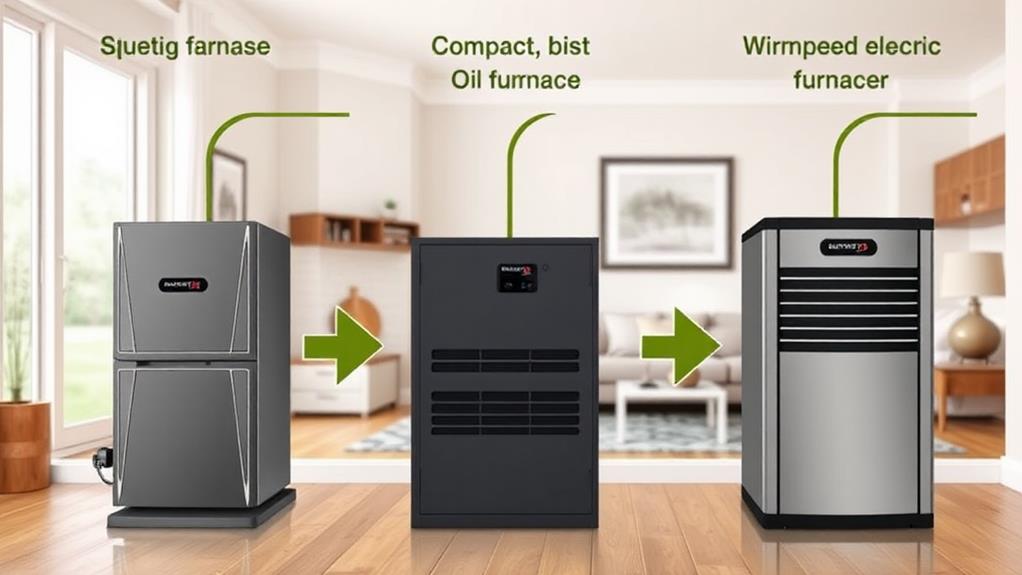
Now that you've considered the environmental impact of different furnace types, it's time to focus on selecting the best option for your home. Begin by assessing your heating needs, taking into account your home's size, climate, and existing infrastructure.
If you have access to natural gas, a high-efficiency gas furnace might be your best bet, offering both cost-effectiveness and lower emissions compared to oil furnaces.
For homes without gas lines, electric furnaces are worth considering. They're clean, require minimal maintenance, and work well in milder climates. However, they can be expensive to operate in colder regions. Oil furnaces remain a viable option for some, especially in areas where oil is readily available and competitively priced.
Don't forget to factor in the furnace's AFUE (Annual Fuel Utilization Efficiency) rating. Higher ratings mean greater efficiency and lower operating costs. Also, consider the initial investment versus long-term savings. While more efficient models may cost more upfront, they'll save you money over time through reduced energy bills.
Lastly, consult with HVAC professionals to ensure proper sizing and installation, as these factors significantly impact your furnace's performance and efficiency.
Conclusion
You've explored gas, oil, and electric furnaces, weighing their efficiency, costs, and environmental impacts. Now it's time to make your choice. Consider your budget, your home's infrastructure, and your local energy prices. Remember, the most efficient furnace isn't always the best fit for everyone. Whether you opt for gas, oil, or electric, you'll be heating your home more efficiently, saving money, and reducing your carbon footprint. Choose wisely, and stay warm!
